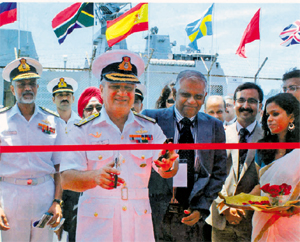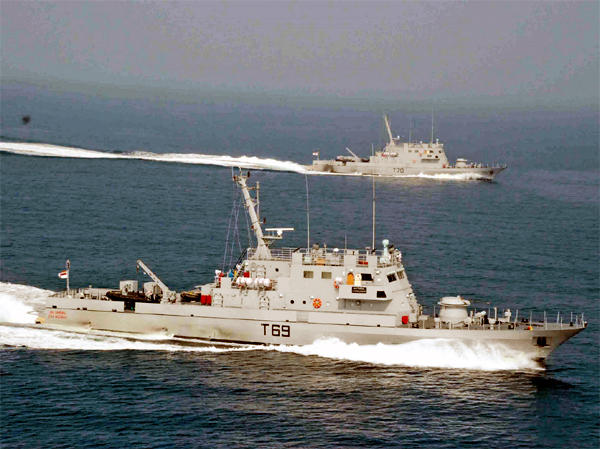|
The IOR has traditionally been India’s
backyard and India has close cultural and political
affinities with the island states in the region.
India’s Maritime Military Strategy clearly
states that the Indian Navy is mandated to safeguard
the vital SLOCs in the IOR region. USA tacitly
supports India’s role seeking partnership.
With that in view, the Indian Navy had ordered
a 43,500-tonne aircraft carrier INS Vikramaditya
in Russia in 2007, and currently has an expansion
plan with forty six ships on order in Indian shipyards.
Vikramaditya has completed sea and flying trials
and will be transferred to India in Russia in
mid-November. Defence Minister AK Antony is slated
to attend the ceremony and Captain Suraj Berry
a Gunnery specialist will take command and embark
MiG-29Ks and Ka-31 AEW helicopters when it arrives
in Indian waters. The aircraft carrier will be
a potent addition to the Indian Navy in its quest
to become a true ‘Blue Water Navy’.
With its crew of 1,400 officers and sailors
INS Vikramaditya will be under a guarantee clause,
for a year and Russia is finalizing a contract
with an Indian company to offer support. The major
issue that currently confronts the expanding Indian
Navy and the Coast Guard is to transform India
into a 21st Century maritime power and that too
within limited financial resources that are made
available, and increasing operational demands.
This calls for rapid indigenisation and efficient
‘in country’ warship building with integration
of systems for ships, submarines and planes.
 NAMEXPO
2013 Exhibition NAMEXPO
2013 Exhibition
The Indian Navy order book is large and worth
Rs 65,000 crore and has active participation of
India’s public and private shipyards, and
industries, who rely heavily on import of machinery,
weapons and ancillary systems from abroad. It
was no wonder NAMEXPO from September 23-27 at
Kochi, India’s first privately organised
Maritime Exhibition and Conference by the Confederation
of Indian Industries (CII) at Cochin Port Trust’s
expansive air-conditioned passenger terminal with
a sea frontage, was well received and very well
attended.
The Cochin port has historical significance
as it was here that the Dutch and the Portuguese
arrived before the British in the 16th century
and Cochin became an important commercial hub
for India’s spice trade. NAMEXPO lived up
to the aspirations of the Chief of Naval Staff
quoted above, with senior officers of the Navy
chairing sessions and delivering papers along
with industry officials from India and abroad
in free flowing deliberations. Indigenisation,
modern shipbuilding techniques, participation
of Small and Medium Enterprises (SMES) and off
sets were high on the agenda.
India’s Ministry of Defence (MOD), the
DRDO, BrahMos Aerospace Ltd, the Government of
Kerala, and the Navy fully supported the event.
The arrangements by the Southern Naval Command
including the MARCOS under water attacks on a
sea borne platform, and Search and Rescue (SAR)
demonstrations executed in the Mattancherry channel
by Alouette and Dhruv ALH helicopters next to
the famed Malabar Hotel and Chinese fishing nets
and three Indian built naval ships berthed alongside
and ‘opened to delegates’, contributed
to the varied maritime attractions of the exhibition.
The bi-annual DEFEXPO naval exhibition held in
New Delhi cannot replicate the atmosphere.
The event was jointly inaugurated by Kerala’s
Minister for Ports and Fisheries K Babu and Flag
Officer Commanding-in-Chief Southern Naval Command
Vice Admiral Satish Soni a specialist navigator
who spoke on advances and changes in naval warfare
and the need for self-reliance through joint development
by DRDO, Indian industry and foreign partners.
Soni assured that the Indian Navy would not be
found wanting to provide support. In a welcome
address Dr A Sivatanu Pillai the CMD of BrahMos
Aerospace Ltd which has an order book of over
Rs 20,000 crore spoke on how the Brahmos supersonic
missile in service with the Navy and Army, is
striving to become 80 per cent Indian in content
by sub-contracting Indian suppliers. Pillai stated
that the air launched lighter 2-tonne BrahMos
missile released from an aluminum container will
be tested from a specially modified Su-30 MKI
fighter in Russia later this year. He also touched
on the export potential of the missile to friendly
countries. The DRDO pavilion displayed Navy’s
sonars, torpedoes, submarine decoys and autonomous
underwater vehicles (AUV).
A total of forty four entities displayed at
the exhibition. The large air conditioned space
was occupied by a handful of foreign companies
from Russia which included Rosboronexport Jsc,
Russian Technologies, Russian shipyards and Rubin.
Others were SAAB from Sweden which has completed
the AIS set up on the 84 radar stations along
the coast for coastal security and secured an
order for self-protection suites for the Dhruv
helicopters by Hindustan Aeronautics Ltd. Selex
from Italy, Westland from UK, electronics supplier
Elbit from Israel, ShinMaywa from Japan looking
to supply the amphibious US-1 planes, shipbuilder
Dearsan Gemilnsaat from Turkey and Eurocopter
from Germany and twenty five Indian exhibitors
with pavilions and stalls exhibited. Representatives
of many Indian and foreign firms as delegates,
and defence attaches and diplomats from Delhi
attended, and hosted functions.

BrahMos Aerospace Ltd (BAL) also displayed a
big exhibit outdoor, close to the Type 17 Shivalik
class INS Satpura (F-48), Fast Attack Craft Kabra
(T-76) and Sail Training Ship Tarangini, all ships
built in Indian yards which were berthed on the
jetty opposite the exhibition, with clearance
for registered delegates to visit and walk around
the ships. On board, the visitors were shown a
display of indigenous fittings and the working
of some weapons and equipment. The Indian Navy
has a vigorous indigenisation drive directed by
the Directorate of Indigenisation under Commodore
Aseem at New Delhi with branches at Mumbai and
Vishakapatnam.
Engineering major Larsen and Toubro Ltd (L&T)
which has bought out Thalest, the UK-based holding
company of Servowatch Systems Ltd., Bond Instrumentation
& Process Control Ltd. and Servowatch of the
US for $5.2 million has contributed the most in
building India’s nuclear submarine INS Arihant,
and supplies a host of equipment from steering
gear, stabilizers, launchers, integrated power
management systems (IPMS) etc, had a large pavilion
at the Exhibition. Other Indian companies also
displayed their hardware and services. Two cable
suppliers – Radiant from Bangalore and Nicco
from Kolkata – and nylon hawser maker Garware
displayed their products seeking export orders.
Other stalls with aviation, ship borne, coastal
security, propulsions and ancillary naval equipment
including boats by Samudra Boat Builders Ltd which
has orders from the Navy provided a rare opportunity
to partake in what is the fastest emerging maritime
market in the Indian Ocean Region.
NAMEXPO 2013 Conference
Rear Admiral AB Singh, Assistant Chief of Naval
Staff (Policy and Plans) at the event, stated
the Navy is set to order twenty more platforms
and listed the many large infrastructure programmes
of the Navy like the Karwar Seabird Phase Two
expansion for the home base of INS Vikramaditya
and other ships sanctioned by the Government.
He also listed the modernisation plans of ships
and dockyards, and the augmentation of the Naval
Academy at Ezimalai near Calicut. The Navy and
Coast Guard speakers at the conference stressed
the need for larger infrastructure ashore to support
the increase in platforms and operational demands.
The first day of the conference was devoted
to themes related to modern trends in warship
and submarine construction by naval experts. Inaugurating
the sessions Vice Admiral NN Kumar, Chief of Material
spoke of naval plans and Nikhil Gandhi Chairman
of Pipavav Defence & Off Shore Engineering
Ltd which has begun construction of the five Naval
OPVs for around Rs 2,800 crore based on a design
from Alion of Canada pressed for more naval orders,
and asked the Government to show more confidence
in private shipyards. Pipavav has signed a Joint
Venture (JV) with Mazagon Docks Ltd and has spare
capacity and has tie ups with SAAB, Northrop Grumman
and DCNS. Rear Admiral Leif Nylander Chief of
Swedish Armed Forces’ Procurement spoke of
the suitability of Visby class OPVs for the Indian
scenario and the A-26 new Swedish submarine programme,
which evinced a barrage of questions by Indian
Naval constructors who are designing submarine
modules for India’s nuclear submarines. INS
Arihant India’s first nuclear submarine is
awaiting arrival of a rescue vessel from Russia
at the Ship Building Centre (SBC) in Vishakapatnam
for sea and diving trials, as her reactor has
tested critical. INS Aridaman the second nuclear
submarine with larger missile plugs and another
hull are under construction at SBC.
The second day of NAMEXPO was devoted to future
‘Marine Propulsion and Power Generation Management
Technologies’, and ‘Consortium and Dual
Use Technology Approach Towards Development of
Naval Weapons and Sensors’ and an afternoon
for ‘Development of Advanced Naval Aviation
Systems and Sustainable Repair Support’.
A half day was devoted to unveil the progress
made by the Navy in its thrust for indigenisation
and discussions took place on means to bring in
more participation by Small and Medium Enterprises
(SMEs) as the Defence Procurement Procedure 2013
amendments, provides preference to SMEs to participate
in the tenders and off sets with a 15 per cent
preferential in the price quotations for a quantum
of the orders.
Conclusion
NAMEXPO-2013 brought out the irony and transformational
challenges faced by Indian Navy in its rapid expansion
which leans heavily on the over-stretched infrastructure.
It also brought out the need for efforts by all
stakeholders concerned to control delays in indigenous
ship building and cost over runs. India with a
rising $1.3 trillion GDP and 1.3 billion population,
and a unique geo-political position in the IOR
with interests in West and South East Asia portends,
that India will have to play an increasing role
in world affairs. The Indian Navy will be called
to play a greater role in protecting India’s
influence and interests with power and reach for
which it has to grow fast. In that quest NAMEXPO-2013
was a very laudable effort by the Navy to get
all stake holders to discuss the challenges and
offer solutions with CII’s organisational
skills as the platform provider.
|